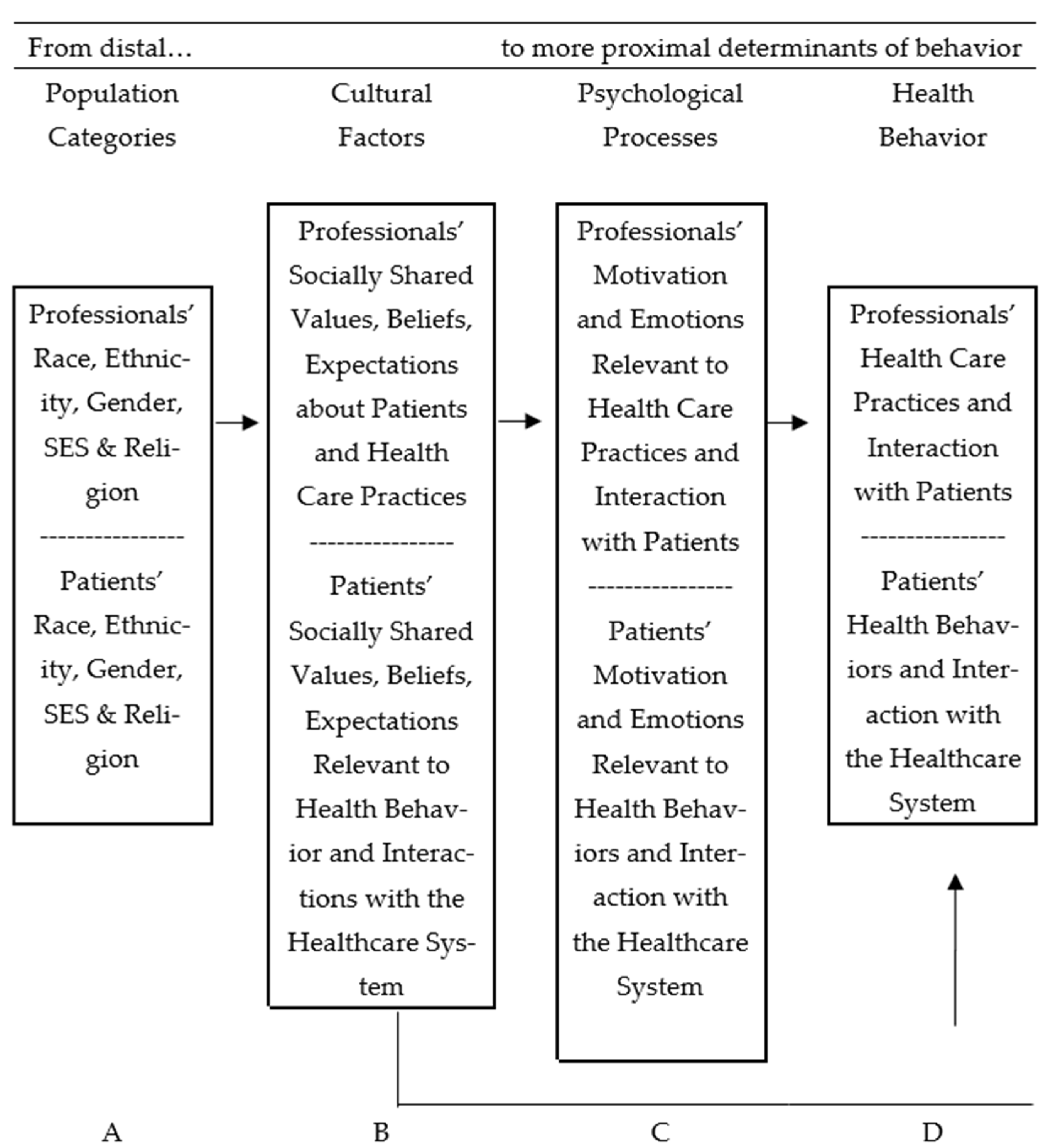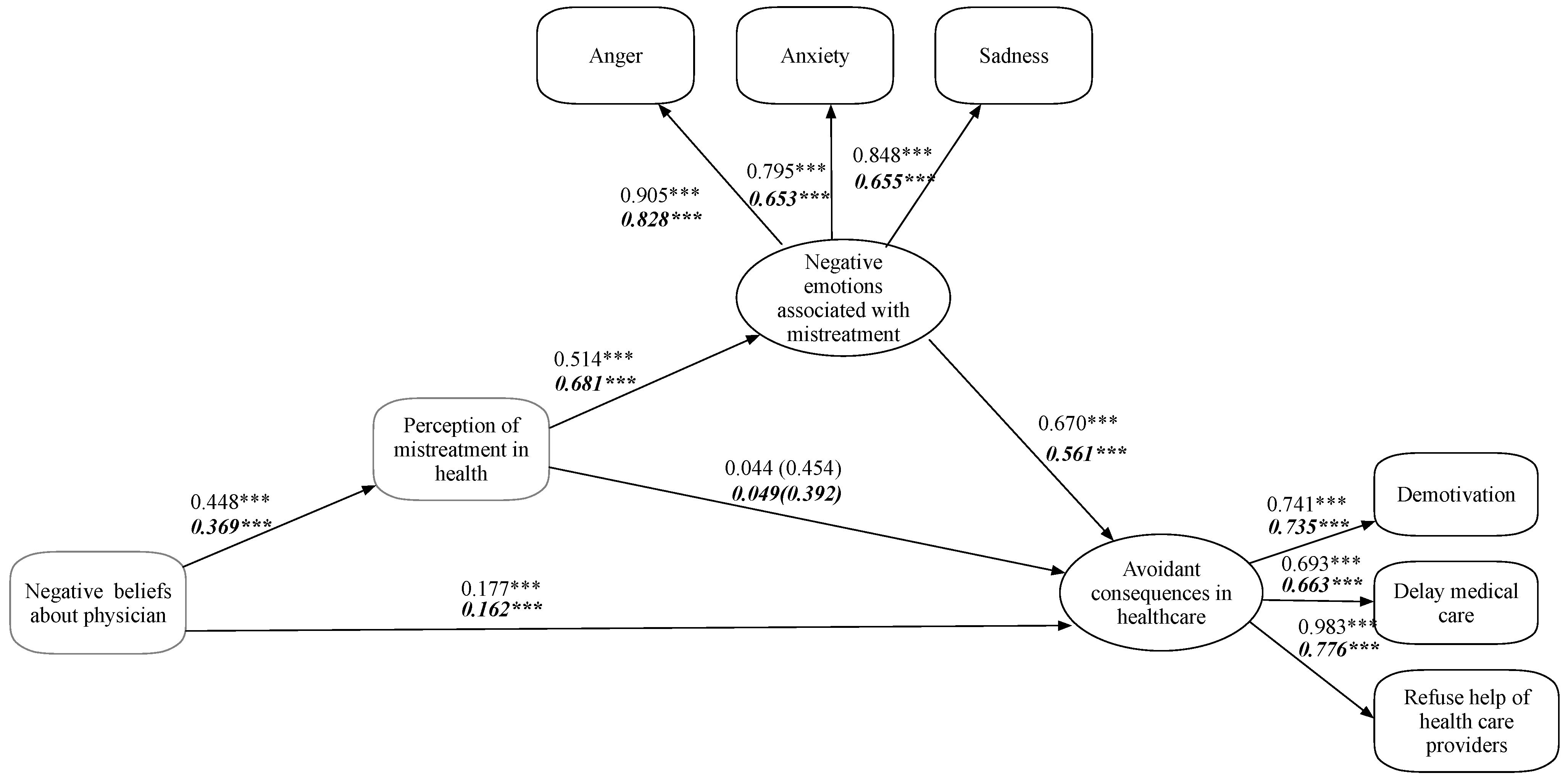Model to Predict Healthcare Behaviors: Comparison of a Chilean and Mexican Sample
Abstract
1. Introduction
2. Materials and Methods
2.1. Participants
2.2. Instruments
2.3. Procedure
2.4. Statistical Analyses
3. Results
3.1. Sociodemographic Characteristics and Comparison between Groups
3.2. Association among Variables of Interest
3.3. Multigroup Structural Equation Modeling
4. Discussion
5. Conclusions
Supplementary Materials
Author Contributions
Funding
Institutional Review Board Statement
Informed Consent Statement
Data Availability Statement
Acknowledgments
Conflicts of Interest
References
- Wagstaff, A.; Dmytraczenko, T.; Almeida, G.; Buisman, L.; Hoang-Vu Eozenou, P.; Bredenkamp, C.; Cercone, J.; Diaz, Y.; Maceira, D.; Molina, S.; et al. Assessing Latin America’s progress toward achieving universal health coverage. Health Aff. 2015, 34, 1704–1712. [Google Scholar] [CrossRef]
- Population Education, a Program of Population Conecction. Stage 4 of the Demographic Transition Model. Available online: https://populationeducation.org/stage-4-demographic-transition-model/ (accessed on 6 July 2022).
- McPhail, S. Multimorbidity in chronic disease: Impact on health care resources and costs. Risk Manag. Healthc. Policy 2016, 9, 143–156. [Google Scholar] [CrossRef]
- World Health Organization. World Health Statistics 2016: Monitoring Health for the SDGs, Sustainable Development Goals; World Health Organization: Geneva, Switzerland, 2016. [Google Scholar]
- Hessel, P.; Sayer, P.; Riumallo-Herl, C. Educational inequalities in disability linked to social security coverage among older individuals in five Latin American countries. Soc. Sci. Med. 2020, 267, 112378. [Google Scholar] [CrossRef]
- di Cesare, M.; Khang, Y.H.; Asaria, P.; Blakely, T.; Cowan, M.J.; Farzadfar, F.; Guerrero, R.; Ikeda, N.; Kyobutungi, C.; Msyamboza, K.; et al. Inequalities in non-communicable diseases and effective responses. Lancet 2013, 381, 585–597. [Google Scholar] [CrossRef]
- Amador, J.A.; Flynn, P.M.; Betancourt, H. Cultural beliefs about health professionals and perceived empathy influence continuity of cancer screening following a negative encounter. J. Behav. Med. 2015, 38, 798–808. [Google Scholar] [CrossRef]
- Salazar-Fernández, C.; Baeza-Rivera, M.J.; Manríquez-Robles, D.; Aedo, M.; Toro, B. Psychosocial factors associated with adherence to self-care behaviors to prevent COVID-19 in Chile. Psykhe, 2022; submitted. [Google Scholar]
- Baeza-Rivera, M.J.; Salazar-Fernández, C.; Araneda-Leal, L.; Manríquez-Robles, D. To get vaccinated or not? Social psychological factors associated with vaccination intent for COVID-19. J. Pacific Rim Psychol. 2021, 15, 18344909211051799. [Google Scholar] [CrossRef]
- Baeza-Rivera, M.J.; Betancourt, H.; Salinas-Oñate, N.; Ortiz, M.S. Health care effects of cultural beliefs about physicians and perceived discrimination. Rev. Med. Chil. 2019, 147, 161–167. [Google Scholar] [CrossRef]
- Baeza-Rivera, M.J.; Betancourt, H.; Salinas-Oñate, N.; Ortiz, M.S.; Marín, O.; Valle, G. Identificación y medición de creencias culturales sobre los médicos: Construcción y validación de un instrumento. Rev. Med. Chil. 2018, 146, 308–314. [Google Scholar] [CrossRef]
- Bird, S.T.; Bogart, L.M.; Delahanty, D.L. Health-related correlates of perceived discrimination in HIV care. AIDS Patient Care STDS 2004, 18, 19–26. [Google Scholar] [CrossRef]
- Burgess, D.J.; Ding, Y.; Hargreaves, M.; van Ryn, M.; Phelan, S. The Association between perceived discrimination and underutilization of needed medical and mental health care in a multi-ethnic community sample. J. Health Care Poor Underserved 2008, 19, 894–911. [Google Scholar] [CrossRef]
- Smedley, B.D.; Myers, H.F. Conceptual and methodological challenges for health disparities research and their policy implications. J. HIV AIDS Soc. Serv. 2014, 70, 382–391. [Google Scholar] [CrossRef]
- Trivedi, A.N.; Ayanian, J.Z. Perceived discrimination and use of preventive health services. J. Intern. Med. 2006, 21, 553–558. [Google Scholar] [CrossRef]
- Bazargan-Hejazi, S.; Bing, E.; Bazargan, M.; Der-Martirosian, C.; Hardin, E.; Bernstein, J.; Bernstein, E. Evaluation of a brief intervention in an inner-city emergency department. Ann. Emerg. Med. 2005, 46, 67–76. [Google Scholar] [CrossRef]
- Matsumoto, D.; Juang, L. Culture and Psychology, 6th ed.; Cengage Learning: Boston, MA, USA, 2016; pp. 203–220. [Google Scholar]
- Flynn, P.M.; Betancourt, H.; Garberoglio, C.; Regts, G.J.; Kinworthy, K.M.; Northington, D.J. Attributions and emotions regarding health care mistreatment impact continuity of care among Latino and Anglo American women. Cultur. Divers. Ethnic Minor. Psychol. 2015, 21, 593–603. [Google Scholar] [CrossRef]
- Hausmann, L.R.M.; Jeong, K.; Bost, J.E.; Ibrahim, S.A. Perceived discrimination in health care and health status in a racially diverse sample. Med. Care 2008, 46, 905–914. [Google Scholar] [CrossRef]
- Flynn, P.M.; Betancourt, H.; Ormseth, S.R. Culture, emotion, and cancer screening: An integrative framework for investigating health behavior. Ann. Behav. Med. 2011, 42, 79–90. [Google Scholar] [CrossRef]
- Vera, J.; Trujillo, A. El efecto de la calidad del servicio en la satisfacción del derechohabiente en instituciones públicas de salud en México. Contaduria y Adm. 2016, 63, 1–22. [Google Scholar] [CrossRef]
- DataBank. Available online: https://datos.bancomundial.org/pais/chile?view=chart (accessed on 6 July 2022).
- Gutiérrez, J.P.; Heredia-Pi, I.; Hernández-Serrato, M.I.; Pelcastre-Villafuerte, B.E.; Torres-Pereda, P.; Reyes-Morales, H. Desigualdades en el acceso a servicios, base de las políticas para la reducción de la brecha en salud. Salud Publica Mex. 2019, 61, 726. [Google Scholar] [CrossRef]
- Baeza-Rivera, M.J.; Salinas-Oñate, N.; Ortiz, M.S.; Villanueva, M.; Díaz-Loving, R. Escala para medir creencias sobre médicos: Adaptación y evidencias de validez y confiabilidad en adultos mexicanos. Acta de Investig. Psicol. 2021, 11, 40–48. [Google Scholar] [CrossRef]
- Baeza-Rivera, M.J. Discriminación Percibida y Sus Consecuencias en las Conductas de Cuidado de la Salud: Un Estudio Multifactorial. Ph.D. Thesis, Universidad de La Frontera, Temuco, Chile, 2015. [Google Scholar]
- Baeza-Rivera, M.J.; Salinas-Oñate, N.; Escandón-Nagel, N.; Caamaño-Mardones, E. Validación de la escala de reacciones ante experiencias de trato desigual en salud. Rev. Cienc. de la Salud 2020, 18, 1–15. [Google Scholar] [CrossRef]
- Byrne, B.M. Structural Equation Modeling with EQS. Basic Concepts, Applications, and Programming, 2nd ed.; Routledge: New York, NY, USA, 2006; pp. 226–249. [Google Scholar]
- Cheung, G.; Rensvold, R.B. Evaluating goodness-of-fit indexes for testing measurement invariance. Structural Equation Modeling. Struct. Equ. Modeling 2002, 9, 233–255. [Google Scholar] [CrossRef]
- Ortiz, M.S.; Fernández-Pera, M. Modelo de Ecuaciones Estructurales: Una guía para ciencias médicas y ciencias de la salud. Ter. Psicol. 2018, 36, 51–57. [Google Scholar] [CrossRef]
- Díaz-Guerrero, R. A Mexican psychology. Am. Psychol. 1977, 32, 934–944. [Google Scholar] [CrossRef]
- Palacios, J.R.; Bustos, M.; Soler, L. Factores socioculturales vinculados al comportamiento proambiental en jóvenes. Revista de Psicol. 2015, 24, 1–16. [Google Scholar] [CrossRef]
- de Leersnyder, J.; Boiger, M.; Mosquita, B. Cultural regulation of emotion: Individual, relational, and structural sources. Front. Psychol. 2013, 4, 55. [Google Scholar] [CrossRef]
- Karasawa, M.; Asai, N.; Tanabe, Y. Stereotypes as shared beliefs: Effects of group identity on dyadic conversations. Group Process Intergroup Relat. 2007, 10, 515–532. [Google Scholar] [CrossRef]
- Santander, J.; Pinedo, J.; Repetto, P. Enseñanza de psicología médica en las escuelas de medicina chilenas. Rev. Med. Chil. 2012, 140, 946–951. [Google Scholar] [CrossRef]
- Rivera-Dommarco, J. Acceso universal a la salud: Los nuevos caminos de una búsqueda permanente. Salud Publica Mex. 2019, 61, 561–562. [Google Scholar] [CrossRef]
- Flynn, P.M.; Betancourt, H.; Emerson, N.D.; Nunez, E.I.; Nance, C.M. Health professional cultural competence reduces the psychological and behavioral impact of negative healthcare encounters. Cultur. Divers. Ethnic Minor. Psychol. 2020, 26, 271–279. [Google Scholar] [CrossRef]
- Hayes, A. Introduction to Mediation, Moderation, and Conditional Process Analysis. A Regression-Based Approach, 2nd ed.; The Guilford Press: New York, NY, USA, 2018; pp. 80–100. [Google Scholar]


| Variable | Chile | Mexico | Test to Compare Groups | Effect Size |
|---|---|---|---|---|
| Sex | 2 = 37.346; p < 0.001 | V = 0.238 | ||
| Women | 85.4% | 64.9% | ||
| Men | 14.6% | 35.1% | ||
| Age | 31.02 (7.46) | 32.89 (14.63) | t = −2.044; p < 0.05 | D = −0.12 |
| Marital status | 2 = 50.427; p < 0.001 | V = 0.27 | ||
| Single | 29.9% | 50.5% | ||
| Married | 44.7% | 33.5% | ||
| Widow/widower | 0.9% | 2.8% | ||
| Divorced | 0.9% | 3.4% | ||
| Separated | 1.8% | 1.6% | ||
| Living together | 21.8% | 8.2% | ||
| Social class | 2 = 17.917; p < 0.01 | V = 0.16 | ||
| Low class | 9.2% | 3.2% | ||
| Lower-middle class | 19.7% | 16.1% | ||
| Middle class | 51.7% | 64.9% | ||
| Upper-middle class | 16.9% | 14.9% | ||
| Upper class | 2.5% | 0.9% | ||
| Educational level | 2 = 21.238; p <0.001 | V = 0.17 | ||
| Less than high school (until 12 years old) | 43% | 56% | ||
| University degree | 47.8% | 41.8% | ||
| Postgraduate degree | 9.2% | 2.2% |
| Negative Beliefs about Physicians | Perception of Mistreatment in Health | Anger | Anxiety | Sadness | Demotivation | Delay Medical Care | Refuse Help of Healthcare Providers | |
|---|---|---|---|---|---|---|---|---|
| Negative beliefs about physicians | - | |||||||
| Perception of mistreatment in health | 0.421 *** | - | ||||||
| Anger | 0.249 *** | 0.494 *** | - | |||||
| Anxiety | 0.187 *** | 0.403 *** | 0.615 *** | - | ||||
| Sadness | 0.275 *** | 0.473 *** | 0.732 *** | 0.636 *** | - | |||
| Demotivation | 0.307 *** | 0.417 *** | 0.425 *** | 0.355 *** | 0.405 *** | - | ||
| Delay medical care | 0.248 *** | 0.402 *** | 0.329 *** | 0.286 *** | 0.338 *** | 0.676 *** | - | |
| Refuse help of healthcare providers | 0.291 *** | 0.403 *** | 0.356 *** | 0.299 *** | 0.380 *** | 0.577 *** | 0.606 *** | - |
| Step | Model | gl | p | RMSEA (IC) | CFI | TLI | SRMR | (SB) | ∆ gl | ∆CFI | |
|---|---|---|---|---|---|---|---|---|---|---|---|
| 1 | Configural model | 23.47 | 30 | 0.80 | 0.000 (0.00–0.04) | 1.00 | 1.00 | 0.02 | - | - | - |
| 2 | Measurement equivalence | 32.39 | 34 | 0.55 | 0.000 (0.00–0.04) | 1.00 | 1.00 | 0.03 | 8.92 | 4 | 0.00 |
| 3 | Structural equivalence | 51.63 | 35 | <0.05 | 0.042 (0.01–0.07) | 0.99 | 0.98 | 0.07 | 19.24 | 1 | 0.01 |
Publisher’s Note: MDPI stays neutral with regard to jurisdictional claims in published maps and institutional affiliations. |
© 2022 by the authors. Licensee MDPI, Basel, Switzerland. This article is an open access article distributed under the terms and conditions of the Creative Commons Attribution (CC BY) license (https://creativecommons.org/licenses/by/4.0/).
Share and Cite
Rivera Baeza, M.J.; Salinas-Oñate, N.; Gómez-Pérez, D.; Díaz-Loving, R.; Ortiz, M.S. Model to Predict Healthcare Behaviors: Comparison of a Chilean and Mexican Sample. Int. J. Environ. Res. Public Health 2022, 19, 10067. https://doi.org/10.3390/ijerph191610067
Rivera Baeza MJ, Salinas-Oñate N, Gómez-Pérez D, Díaz-Loving R, Ortiz MS. Model to Predict Healthcare Behaviors: Comparison of a Chilean and Mexican Sample. International Journal of Environmental Research and Public Health. 2022; 19(16):10067. https://doi.org/10.3390/ijerph191610067
Chicago/Turabian StyleRivera Baeza, María José, Natalia Salinas-Oñate, Daniela Gómez-Pérez, Rolando Díaz-Loving, and Manuel S. Ortiz. 2022. "Model to Predict Healthcare Behaviors: Comparison of a Chilean and Mexican Sample" International Journal of Environmental Research and Public Health 19, no. 16: 10067. https://doi.org/10.3390/ijerph191610067
APA StyleRivera Baeza, M. J., Salinas-Oñate, N., Gómez-Pérez, D., Díaz-Loving, R., & Ortiz, M. S. (2022). Model to Predict Healthcare Behaviors: Comparison of a Chilean and Mexican Sample. International Journal of Environmental Research and Public Health, 19(16), 10067. https://doi.org/10.3390/ijerph191610067






